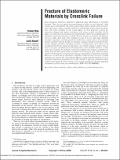Fracture of Elastomeric Materials by Crosslink Failure
Author(s)
Mao, Yunwei; Anand, Lallit
Downloadjam_085_08_081008.pdf (2.196Mb)
PUBLISHER_POLICY
Publisher Policy
Article is made available in accordance with the publisher's policy and may be subject to US copyright law. Please refer to the publisher's site for terms of use.
Terms of use
Metadata
Show full item recordAbstract
If an elastomeric material is subjected to sufficiently large deformations, it eventually fractures. There are two typical micromechanisms of failure in such materials: chain scission and crosslink failure. The chain scission failure mode is mainly observed in polymers with strong covalent crosslinks, while the crosslink failure mode is observed in polymers with weak crosslinks. In two recent papers, we have proposed a theory for progressive damage and rupture of polymers with strong covalent crosslinks. In this paper, we extend our previous framework and formulate a theory for modeling failure of elastomeric materials with weak crosslinks. We first introduce a model for the deformation of a single chain with weak crosslinks at each of its two ends using statistical mechanics arguments, and then upscale the model from a single chain to the continuum level for a polymer network. Finally, we introduce a damage variable to describe the progressive damage and failure of polymer networks. A central feature of our theory is the recognition that the free energy of elastomers is not entirely entropic in nature; there is also an energetic contribution from the deformation of the backbone bonds in a chain and/or the crosslinks. For polymers with weak crosslinks, this energetic contribution is mainly from the deformation of the crosslinks. It is this energetic part of the free energy which is the driving force for progressive damage and fracture of elastomeric materials. Moreover, we show that for elastomeric materials in which fracture occurs by crosslink stretching and scission, the classical Lake-Thomas scaling - that the toughness Gc of an elastomeric material is proportional to 1/√G₀, with G₀ = NκBγ the ground-state shear modulus of the material - does not hold. A new scaling is proposed, and some important consequences of this scaling are remarked upon.
Date issued
2018-06Department
Massachusetts Institute of Technology. Department of Mechanical EngineeringJournal
Journal of Applied Mechanics
Publisher
ASME International
Citation
Mao, Yunwei, and Lallit Anand. “Fracture of Elastomeric Materials by Crosslink Failure.” Journal of Applied Mechanics 85, 8 (June 2018): 081008 © 2018 ASME International
Version: Final published version
ISSN
0021-8936
1528-9036